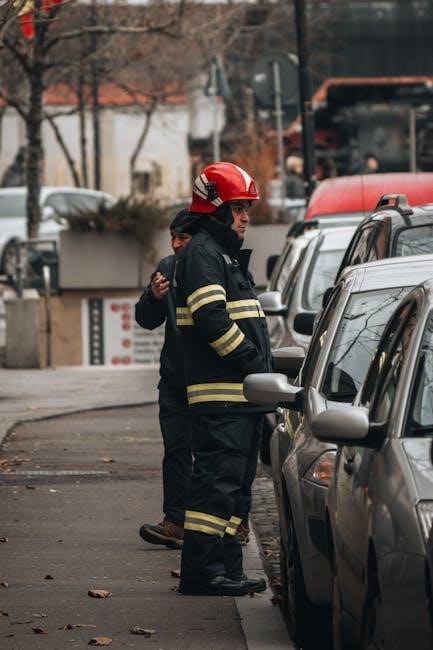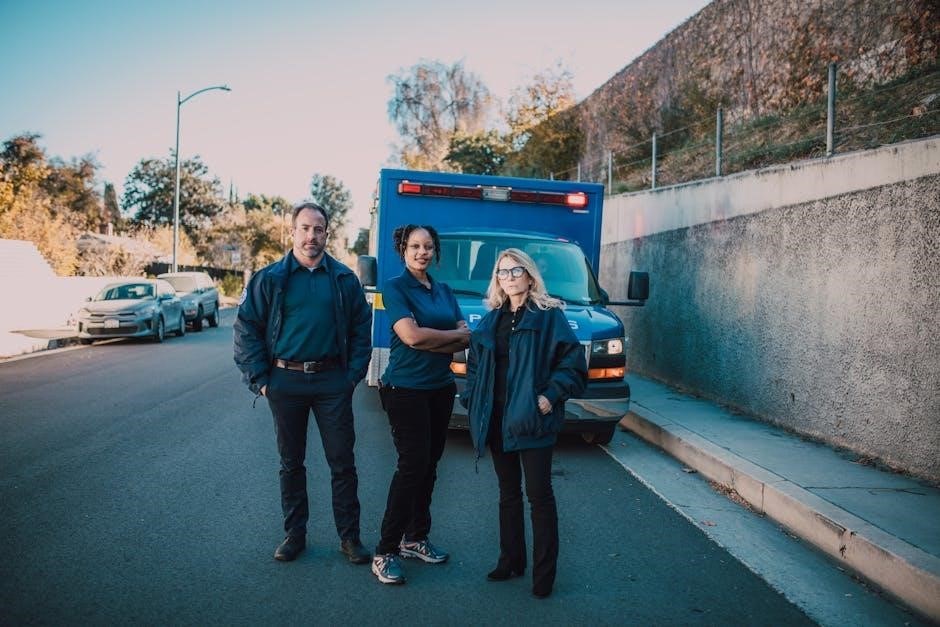
carbon monoxide detector first alert manual
Welcome to the First Alert Carbon Monoxide Detector Manual. This guide provides essential information for safe installation, operation, and maintenance of your CO detector, ensuring your home’s protection.
Overview of the First Alert Carbon Monoxide Detector
The First Alert Carbon Monoxide Detector is a reliable, user-friendly device designed to protect homes from the dangers of carbon monoxide (CO). It features advanced detection technology to identify CO levels and alert residents with an 85dB alarm and flashing red light. Suitable for residential use, this detector offers a silence feature to temporarily mute unnecessary alarms. With a low battery warning and robust construction, it ensures continuous monitoring of CO levels. The detector is UL certified, meeting strict safety standards, and provides peace of mind for homeowners. Its compact design and easy installation make it a practical addition to any home safety system.
Importance of Carbon Monoxide Detectors in Home Safety
Carbon monoxide (CO) detectors are crucial for home safety as they detect this odorless, invisible gas, which can be deadly in high concentrations. CO poisoning can cause severe health issues, including dizziness, nausea, and even death. Detectors provide early warnings, allowing residents to evacuate and seek help before levels become dangerous. According to the NFPA, CO detectors should be installed on every level of a home and near sleeping areas. They are especially important in homes with fuel-burning appliances, like furnaces or water heaters, as these can produce CO. Regular maintenance and proper placement ensure these devices function optimally, safeguarding lives and preventing tragedies.
Installation and Setup
Proper installation ensures your First Alert CO detector functions optimally. Place detectors on every level, near sleeping areas, and avoid garages or kitchens. Follow manual instructions for wiring and battery setup to guarantee accurate alerts and home safety.
Step-by-Step Installation Guide for the First Alert CO Detector
- Choose the right location: Install detectors on every level of your home, including near sleeping areas and basements, but avoid garages or kitchens.
- Mount the detector: For standard ceilings, place the detector within 3 feet of the peak on peaked or gabled ceilings. Use the provided mounting hardware for secure installation.
- Insert the battery: Open the battery compartment and insert the included lithium battery. Ensure it clicks into place for proper power supply.
- Test the alarm: Press and hold the “Test” button until the alarm sounds. This confirms the detector is operational and ready for use.
Follow these steps to ensure your First Alert CO detector is installed correctly and functions effectively, providing reliable protection against carbon monoxide threats.
Recommended Placement of Carbon Monoxide Detectors in the Home
Proper placement of carbon monoxide detectors is crucial for effective protection. Install detectors on every level of your home, including basements and near sleeping areas. Position them at least 10 feet away from fuel-burning appliances like furnaces or water heaters to avoid false alarms. On ceilings, place detectors within 12 inches of the peak but not closer than 3 feet to walls. In rooms with sloped ceilings, mount them within 3 feet of the highest point. Avoid areas near windows, doors, or vents to ensure accurate detection. Follow these guidelines to maximize your home’s safety and comply with local safety standards.
Wiring and Battery Installation Instructions
For hardwired First Alert CO detectors, connect the black and white wires to the home’s electrical system and the red wire to the interconnect terminal. Ensure the circuit is switched off during installation. For battery-operated models, insert the provided lithium battery, ensuring the polarity matches the diagram. Replace batteries annually or when the low-battery chirp sounds. Never use a rechargeable battery. If your detector has a plug-in design, insert the battery as a backup power source during outages. Always test the detector after installation to confirm proper function. Follow these steps to ensure reliable performance and maintain your home’s safety system.
Features and Specifications
First Alert CO detectors feature advanced sensor technology, 85dB alarms, and silence functions. Some models include digital displays, battery backup, and voice alerts for enhanced safety and convenience.
Types of Carbon Monoxide Detection Technology
First Alert carbon monoxide detectors utilize advanced sensor technologies to ensure accurate and reliable detection. These include:
- Biomimetic Sensors: These sensors mimic the behavior of human hemoglobin, providing quick and precise CO detection.
- Electrochemical Sensors: Known for high sensitivity and long-term stability, these sensors offer consistent monitoring of CO levels.
- Optical Sensors: Using infrared technology, these sensors detect CO by measuring changes in light absorption, ensuring minimal false alarms.
Each technology is designed to provide early warning of dangerous CO levels, ensuring your family’s safety and peace of mind.
Alarm Features and Warning Signals

First Alert carbon monoxide detectors are equipped with advanced alarm features to ensure immediate notification of potential threats. The device emits a loud 85dB alarm, which is audible even in larger homes. Additionally, a flashing red light provides a visual warning, ensuring alerts are noticeable to everyone, including those with hearing impairments. Some models also feature a voice alarm that clearly announces “Carbon Monoxide” to avoid confusion. The detector includes a low battery warning and a silence feature to temporarily mute unnecessary alarms. These features work together to provide reliable and clear warnings, helping you respond quickly to dangerous CO levels. Always take alarms seriously and follow safety guidelines if the detector activates.
Battery Life and Low Battery Indications
First Alert carbon monoxide detectors are designed to provide long-lasting reliability with their battery-powered models. The battery life typically ranges from 5 to 10 years, depending on the model and usage. To ensure continuous protection, the detector includes a low battery warning, which emits a distinct chirping sound and flashes a red light when the battery level is low. Replace the battery promptly to maintain functionality. Some models feature a sealed lithium battery that lasts the unit’s lifetime, eliminating the need for replacements. Always refer to your specific model’s manual for battery replacement instructions and guidelines to ensure optimal performance and safety.

Maintenance and Troubleshooting
Regularly clean the detector with a soft brush to remove dust. Test the alarm monthly and ensure batteries are fresh. Refer to the manual for troubleshooting common issues like false alarms or chirping sounds, and replace detectors every 10 years for optimal safety.
Regular Maintenance Tips for Optimal Performance
For optimal performance, clean your First Alert CO detector regularly using a soft brush or vacuum cleaner to remove dust and debris. Test the alarm monthly by pressing the test button to ensure proper functionality. Inspect the detector for any physical damage or wear and tear. Replace the battery annually or as indicated by the low-battery warning. Refer to the user manual for specific maintenance instructions tailored to your model. Ensure the detector is replaced every 10 years, as sensor sensitivity diminishes over time. Regular maintenance ensures your detector remains reliable and provides continuous protection against carbon monoxide threats.
Troubleshooting Common Issues with the Detector
Common issues with your First Alert CO detector include false alarms, low battery warnings, or failure to detect CO. If the alarm sounds without CO presence, check for dust or moisture interference. Press the silence button to stop the alarm and clean the detector. For low battery warnings, replace the battery immediately. If the detector fails to respond, ensure it is properly installed and not expired. Refer to the manual for troubleshooting guides specific to your model. If issues persist, contact First Alert support for assistance. Regular maintenance and adherence to manufacturer guidelines ensure your detector functions correctly and provides reliable protection against CO threats.

When to Replace the Carbon Monoxide Detector
Replace your First Alert CO detector every 7-10 years, as specified by the manufacturer. Look for an “End of Life” warning, which includes a steady light or beep every 30 seconds. If the detector shows physical damage or fails to respond during tests, it should be replaced immediately. Additionally, upgrade if your current model lacks modern features like digital displays or smart connectivity. Always follow local regulations and ensure compliance with safety standards when replacing your CO detector. A functioning detector is crucial for protecting your household from carbon monoxide threats, so never delay replacement when it is due.

Safety Guidelines and Precautions
Always follow First Alert’s instructions to ensure proper function. Never ignore alarms; evacuate and investigate sources immediately. Keep detectors away from direct heat sources and chemicals.
Understanding Carbon Monoxide Risks and Symptoms
Carbon monoxide (CO) is a colorless, odorless gas produced by incomplete combustion of fuels. Prolonged exposure can lead to severe health issues, including dizziness, nausea, and even death. Symptoms often mimic flu-like conditions, making them difficult to identify. High levels of CO can cause rapid unconsciousness, while lower levels may lead to long-term health problems like brain damage or heart conditions. The First Alert detector helps mitigate these risks by alerting you to dangerous CO levels early, ensuring prompt action to safeguard your household. Always take CO alarms seriously to prevent potential harm.
What to Do When the Alarm Sounds
If your First Alert Carbon Monoxide Detector activates, act immediately. Open windows and doors to ventilate the area, but do not re-enter the home until the alarm stops. Evacuate all occupants, including pets, and call emergency services or your local fire department. Do not attempt to locate the CO source yourself. Turn off any fuel-burning appliances and leave them off until they are inspected by a professional. Stay outside at a safe distance until authorities confirm the area is safe. Remember, CO exposure can be deadly, so prompt action is crucial to protect everyone’s health and safety.
Preventing False Alarms and Ensuring Accuracy
To prevent false alarms and ensure your First Alert Carbon Monoxide Detector operates accurately, follow these guidelines. Install the detector at least 5 feet away from fuel-burning appliances like furnaces or water heaters. Avoid placing it near kitchens or bathrooms, where steam or cooking fumes might trigger false alarms. Keep the detector clean by vacuuming it regularly to remove dust. Replace batteries annually or as indicated by the low-battery warning. Test the alarm monthly using the test/silence button. Never disable the alarm permanently; use the silence feature only temporarily if necessary. Proper installation and maintenance will help ensure reliable performance and reduce false alarms, providing you with accurate protection against CO threats.

Frequently Asked Questions (FAQs)
Explore common questions about First Alert CO detectors, including installation, troubleshooting, and maintenance, to ensure optimal performance and home safety with reliable answers.
Common Questions About First Alert CO Detectors
Users often inquire about the proper placement of First Alert CO detectors, with recommendations to install them on every level of the home and near sleeping areas. Another frequent question concerns the difference between battery-operated and hardwired models, with battery options offering portability and hardwired units providing uninterrupted power. Additionally, many ask about the lifespan of detectors, which typically lasts 5-7 years, and how to interpret alarm signals. Some users also seek guidance on resolving false alarms, which can often be addressed by ensuring proper ventilation and avoiding placement near combustion sources. These questions highlight key aspects of detector functionality and maintenance.
How to Obtain a Replacement Manual or Support
To obtain a replacement manual for your First Alert Carbon Monoxide Detector, visit the official First Alert website or contact their customer support team. You can download PDF versions of manuals for specific models, such as the CO606 or CO400, directly from their website. For a hard copy, call their support line at 1-800-323-9005, and they will provide a replacement for a nominal fee of $5 per manual. Ensure you have your detector’s model number ready for efficient assistance. Additionally, the website offers troubleshooting guides, FAQs, and setup instructions to help you resolve common issues or understand your detector’s operation better.